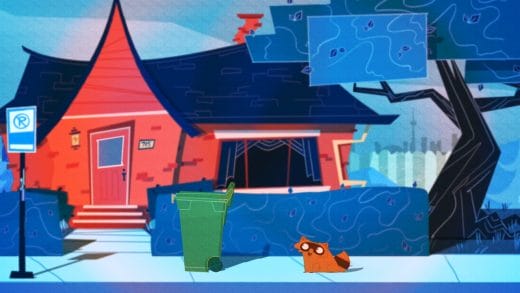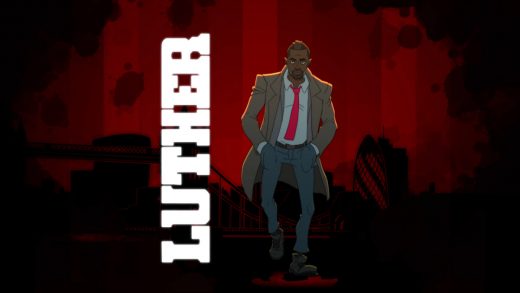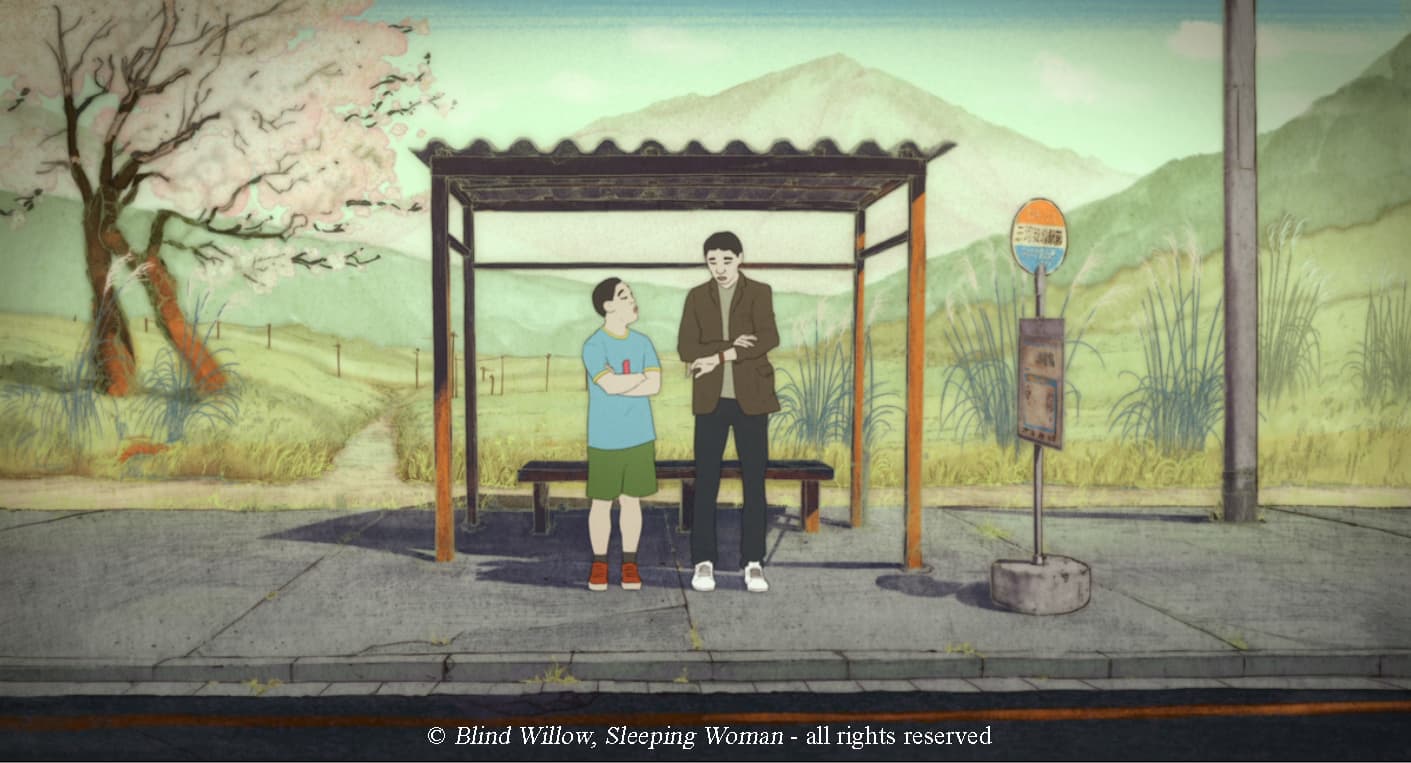
Blind Willow, Sleeping Woman (Saules aveugles, femme endormie) is the first animated film directed by composer Pierre Földes. This is also the first feature film from Miyu Productions, which has a decade of experience in television and critically-acclaimed short films, and is co-produced with Cinema Defacto. Pierre Földes adapted the script from a collection of 6 short stories by the famous Japanese author Haruki Murakami, including the eponymous story where a lost cat and a giant frog help a meek bank employee, his frustrated wife and a schizophrenic accountant save Tokyo from an earthquake and find meaning in their lives.
Veronique Dumon spoke with Pierre Földes, (the film’s writer, director and composer), Tanguy Olivier, (production manager at Miyu), and Emmanuel-Alain Raynal (producer), to discuss the project which began 8 years ago. They discussed the film’s distinctive animation style and process, as well as its journey from a single creator’s project to working on a shared vision with a larger team.
The following interview was translated from French. You can find the original text published by our colleagues at Canopea Formation, which helps studios in France, Belgium, Luxembourg, Sweden, and the Netherlands integrate Harmony and Storyboard Pro into their production pipelines.
Before working on the project with Miyu, you had already worked alone for several years on Blind Willow, Sleeping Woman.
Pierre Földes: Before I optioned for the rights and got Haruki Murakami’s agreement, I had to do some development to convince him, his agents, and his studio. I started from nothing. I was living in Budapest at the time, I worked at first without looking for financing.
I was quite confident. I thought that with a name like that behind me, I would snap my fingers and the producers would rush in. But no… I was new to animation; I was a bit naive. But when you come up with such an ambitious animation project, which is not a film for children, you are confronted with reluctance.
How long did this phase last?
PF: I worked on my own for about 18 months, but while doing other things. I was painting at the time and making music, since I am first and foremost a composer. But my father was an animator. I was born into it, I always had animation as a kind of background.
I started working with an early version of Toon Boom’s software called Toon Boom Studio. I was making little vignettes about urban loneliness. That is what I showed to Mr. Murakami and that is what he liked.
For this project, apart from the script, which was a huge job, I created what can be called a graphic bible. The work on the decorations and especially on the style, it is what is most important for me. Developing a unique style of my own, in parallel with a particular technique. At that time, I had Toon Boom Animate, on which I developed a morph-based technique — with which I made a teaser entirely on my own in three months after developing my characters and scenery.
It got me selected for Cartoon Movie in 2018. And it is on this occasion that I met Tanguy, then at Prima Linea. We worked together on a production process.
My philosophy at the time was really to make beautiful strokes and have the morphs managed, keyframe by keyframe. It was very complicated, but I managed to make something that corresponds to the atmosphere of the film: very ethereal, ultra-fluid.
I like to use a technique that I developed myself, because that is how you will necessarily create a unique style. I like to use a tool and dive in to see what I can do with it.
The film is now made using different techniques?
PF: After the project stopped for the first time, I developed another technique, using live action, with actors and actresses, to really focus on the expressions, the essential part of this film. But the bodies of the characters are not only theirs.
In the case of Frog, which is a 2 meters high frog for example, it is obvious. There is a rotoscoping part, for the keyframes, which are then interleaved more traditionally. The faces are not at all those of the actors. I sculpted the heads in a 3D sculpt software.
They are then imported into Harmony Premium where they serve as a template for the structure, but also force us to rethink the design. They have no expression but each line that the animator must take back when drawing the faces is marked, as if by a chisel. I want to be able to use the accents that you use with your body, with your head, as you do naturally when speaking. And for that, having a 3D marker behind is very practical.
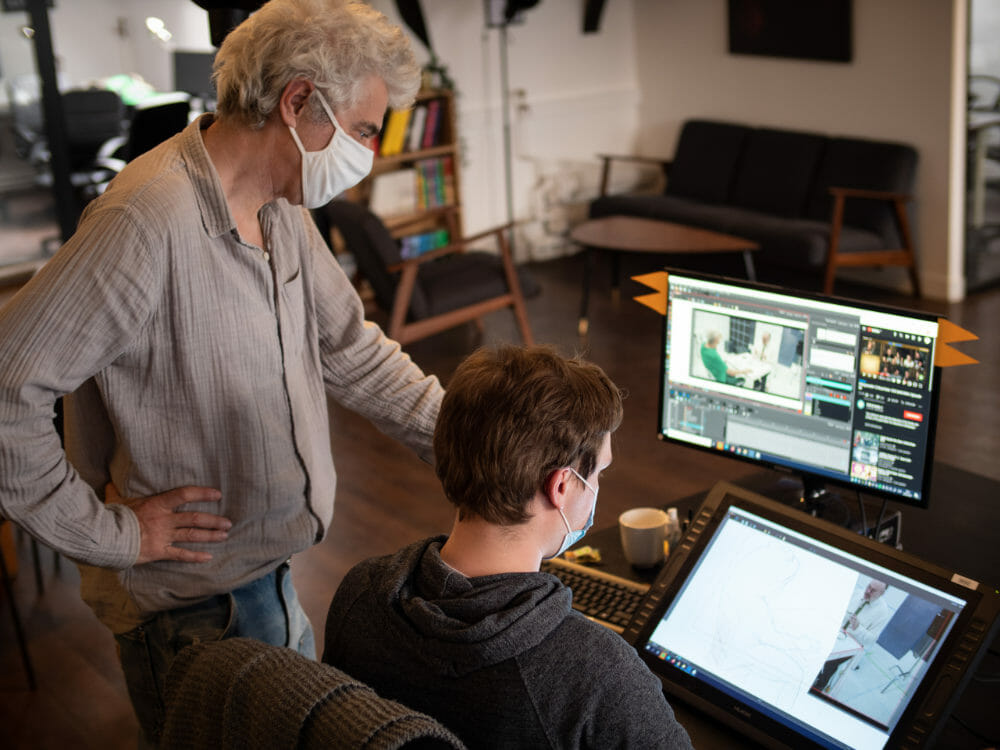
I am still going to keep very small passages that I will probably do myself in morphs, for the extremely fluid effect I mentioned earlier. And there is an emotional side for me, because my father, in the ’70s, was making films like that in Canada, with an ultra-sophisticated morph technique that he had developed with engineers…
[Editor’s note: You can watch Peter Foldès’ 1971 short Metadata, which is one of the first films to make use of what is now known as morphs or shape tweening.]
Tanguy Olivier: Pierre arrived with a very personal work process that he had developed himself around Harmony’s morph tool.
It is a precise and somewhat constraining process that may have destabilized the animators at first, because it is quite far from the one taught in schools. But when we exchanged ideas at a progress meeting, we all realized that it was precisely the fact that they had to break their habits that created the gap that Pierre wanted.
The entire film was first shot in live-action before moving on to the animation stage?
TO: Absolutely, except for some very dreamy scenes. We did a shoot rather close to a traditional shoot. But with decorations represented by white squared plates for markers. And it was all edited, like a real movie.
PF: In fact, at the beginning, this project was to be a little more composited in its technique, not in full animation. It had to be a bit playful, with images, characters, scenery that would stay on video, as pixelated images. A kind of assemblage of different mediums. And then, little by little, by force of circumstance, the project was transformed.
Do you regret the changes?
PF: I regret a little that I was not more adamant about having a rawer image… I like this DIY aspect. This mixture of techniques brings a great richness, a kind of porosity of perception.
But there is still compositing, which is a phase where we can have fun with all this. I love this part.
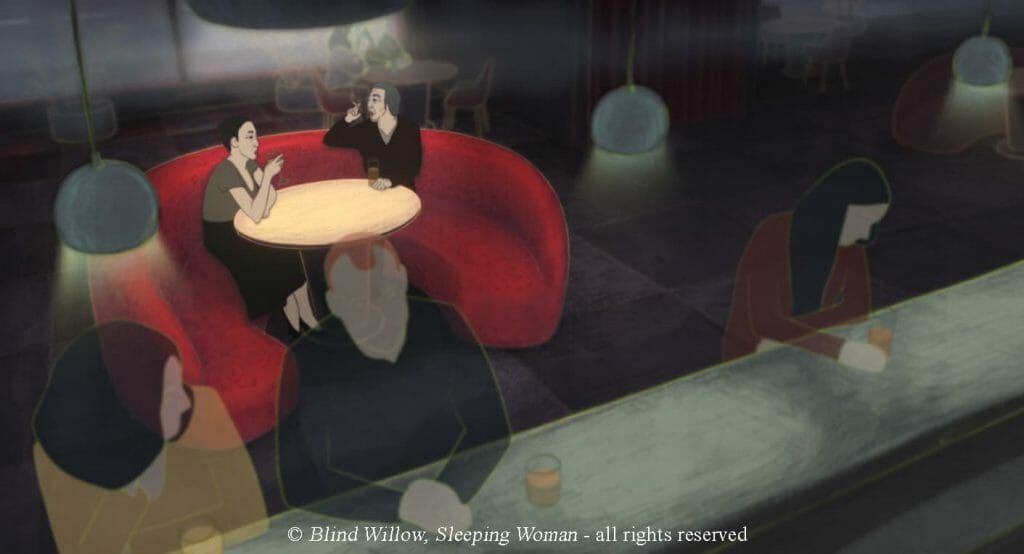
Where are you today in the production process?
TO: We are coming to the end of the animation which was done on four sites: in our three studios in Paris, Angouleme, and Arles, and in Luxembourg, in the studio of our co-producer DogHouse Films. Currently, only Julien Maret, the director of animation on this project, is still in Paris and supervises with lead animators who rely on each of the other sites.
That worried DogHouse at the beginning, as this is the first time we worked with them, especially on a rather particular film. But it is an excellent partner with whom we work in full transparency. Just like us, they quickly realized that putting a filter between Pierre and the animators generated corrections that he did not want, which wasted time.
How many artists worked on the project?
TO: About thirty, which is not much for a project of this type. But it is a choice that has to do with both the technical process we just talked about and the artistic process, which are particularly closely linked on this film.
We asked ourselves many questions about scaling up this process which, at the beginning, was done by Pierre, alone in his corner. How can we make this fit with teamwork? To what extent should animators be specialized, as in a traditional process? We were faced with such an unusual approach that we decided to entrust the entire animation process to each person of the team: the preparation of the 3D heads, the rough drawing, then the graphic adaptation and the final cleanup.
The morphing, which was a little more constraining at the level of preparation, also allows us to work more quickly.
And then Pierre was very concerned about our team’s dispersal. We were already on four locations while he would have liked for everything to be done around him, which is understandable. It was therefore impossible to consider a team of 80 additional artists.
PF: When I came to animation in my ‘old age,’ as a second job, again I was a bit naive. I thought that we were going to be a team of fifteen, in the same room, working together, and that I would be able to whisper in everyone’s ear throughout the production. My approach comes from classical music and I imagined myself as a conductor who decides everything, with a team as an extension of myself.
In animation, it is more difficult. Today, considering all the years that have passed since the project was launched, I would probably have completed this film if I had continued working alone. But I decided to make the film as a team, so as not to end up alone on my deserted island.
There are things I regret and things I am very happy about. We have extraordinary sets, very expressive animation… I think we could have gone further by doing things a little differently, but I am, by nature, always dissatisfied.
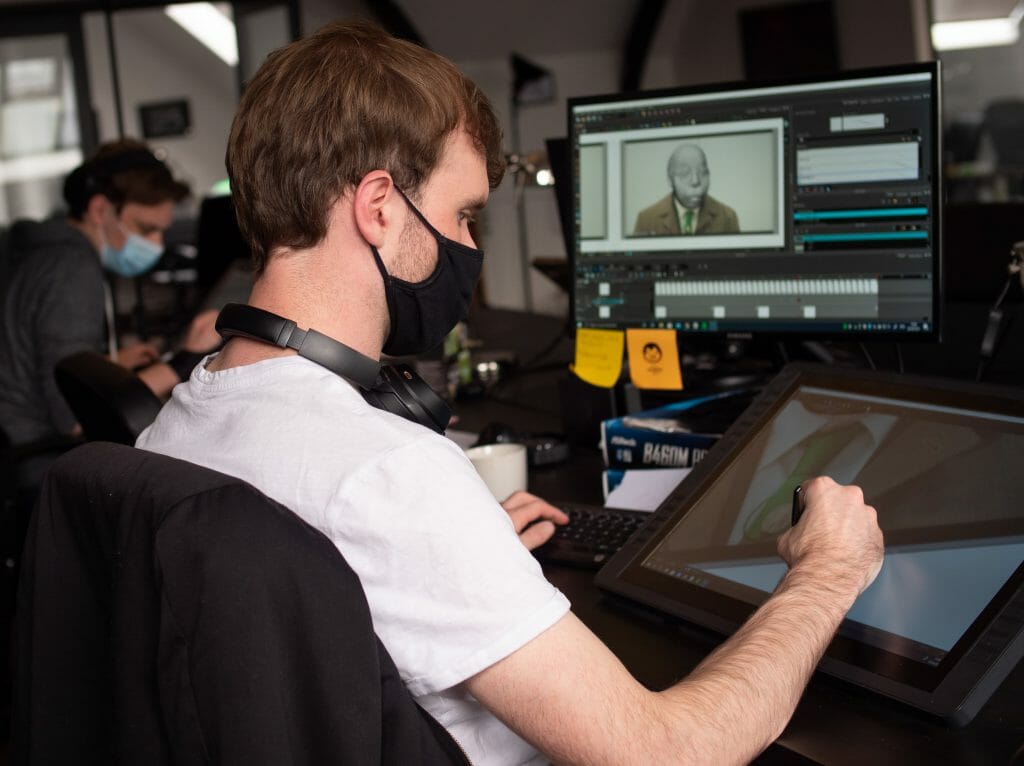
Was Haruki Murakami involved in the process?
PF: He saw things at first. I then contacted him and his team from time to time… He was very encouraging about what he saw and read.
Now that the animation is 80% complete, you are moving on to the next step?
TO: We started compositing, which is done in Canada, in Montreal, at Unité Centrale, also a co-producer. And that is not easy to do with the pandemic. We had planned to bring the head compositor to France to do all the preparation with us. Then, Pierre would go to Canada. In fact, the implementation is much slower and more laborious than we had hoped, but we are getting there.
All the compositing is done on After Effects, as Pierre had done at the beginning, with plugins that he likes to use for the very specific treatment of his line, which is both vector and bitmap.
PF: Because of the crisis, indeed, things needed to be done entirely remotely without having been able to train the people here in the style I want. But I still hope to go to Canada to finish the compositing phase. My role now is to ensure that the boldness of this project is not lost.
When is the delivery of the film scheduled for?
TO: Another exception of this project is that Pierre, who was initially a composer, will also do the music for his film. He will have to compose it after finishing the visuals, this fall, because for the moment, it is impossible to do both at the same time. Delivery is expected at the end of the year, or early next year.
Pierre, do you already have an idea of what the music of Blind Willow, Sleeping Woman will sound like?
PF: I have not started yet, but I am always thinking about it. Anyway, I have music in my head really all the time.
The music will be orchestral, but with a strong electronic sound design. And I even want, if we can, to have a choir on some parts. And then there is a Mozart piano concerto that is performed in the film that I will probably keep and perform!

What does this film mean for Miyu Productions?
Emmanuel-Alain Raynal: This is a particularly important project, as it is our first feature film to go into production. In fact, I first met Pierre in 2014 as part of a co-production setup that ultimately fell through. Then several years passed, and Pierre and Tom Dercourt, then producer of the project, contacted us again in 2017. Following this new discussion, we signed a delegated co-production with Cinema Defacto and finalized the financing.
It is an animated film for an adult audience, which is very important to Miyu. It is also a film with a radical, plastic, and strong proposal, which leaves the usual standards of animated features, and which is carried by a dazzling narration. The script, based on Murakami’s writings, is nevertheless very Földesian, which is an achievement in terms of writing. I believe that it is an important film, a film that will stand out and will count in the history of French animation at least.
What is Miyu’s strategy regarding feature films?
ER: Miyu’s editorial strategy in this field is ultimately the same as for short films. To explore everything, to produce projects that we want to do, to be able to take editorial and financial risks. We produce 56 short films per year, and our ambition is to release a feature film every year and a half.
Saules aveugles, femme endormie (Blind Willow, Sleeping Woman) is also the first film that allowed us to think of a pipeline that we want to centre on the auteur. We are very attentive to what the auteur has developed plastically to create his images. We wanted to be inspired as much as possible by Pierre’s creative vision for his film. This is much more complex in feature films than in short films, between the author’s vision and an industrial pipeline that is essential for a feature film with a budget of 6 million euros and a team of about 70 people spread over several territories.
What are your next feature film projects?
ER: We are entering production this year on two new feature films, Linda veut du poulet! (Chicken for Linda!) by Chiara Malta and Sebastien Laudenbach (in delegated co-production with Dolce Vita Films), with a completely different pipeline that requires a lot of agility with a very small crew, and Planètes (Planets), the first feature film by Momoko Seto (in delegated co-production with Ecce Film) narrating the journey of dandelion achenes propelled into space following the explosion of the Earth and searching for a new soil to plant themselves. The film will mix 3D animation for the characters and time lapse of live action plants for the scenery. Finally, we have just completed the production of A Dozen Norths; the first feature film by Japanese master Koji Yamamura, which we are co-producing with Yamamura Animation, and which was made entirely in traditional paper animation.


